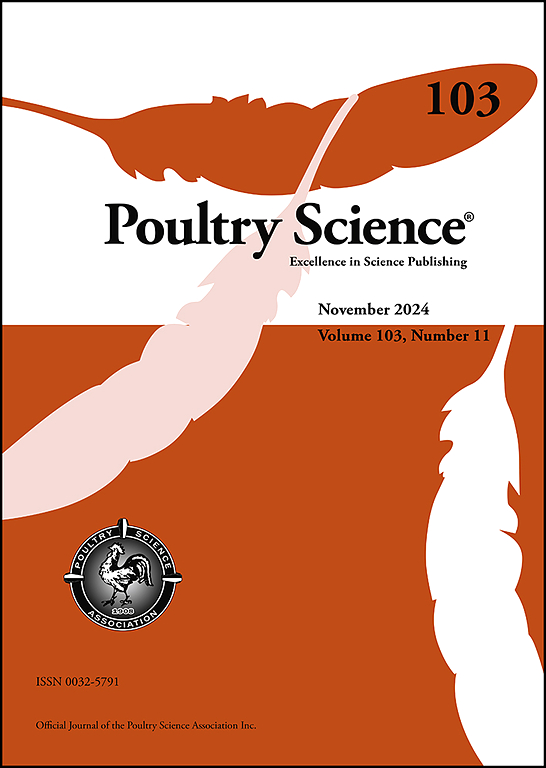一把双刃剑:鸡体内内源性逆转录病毒的多重作用。
IF 4.2
1区 农林科学
Q1 AGRICULTURE, DAIRY & ANIMAL SCIENCE
引用次数: 0
摘要
鸡内源性逆转录病毒(cherv)是一类逆转录病毒衍生的元素,起源于古老的逆转录病毒感染,通过种系传播稳定地整合到禽类基因组中。cherv占鸡基因组的3 ~ 5%,其序列和插入位点独特地阐明了鸟类物种的进化及其与病毒的相互作用。在其漫长的进化过程中,cherv经历了突变和缺失,这些突变和缺失广泛地破坏了它们的自主复制能力,现在只有一部分cherv表现出转录活性。最近的研究还表明,cherv的插入可以导致鸡的性状发生变化,包括生产蓝壳蛋,出现白色羽毛和母鸡的羽毛。cherv对鸡的生物学功能也有双向调节作用。特别是,它们的长末端重复序列可以通过顺式作用元件参与宿主基因的表达,从而调节与胚胎发育相关的基因或干扰素刺激基因的表达。除此之外,虽然内源性逆转录病毒通常可以转录成反义长链非编码rna,从而激活抗病毒先天免疫途径,但cherv也可以与外源性病毒重组,从而引起肿瘤和免疫抑制。最后,cherv可通过与其他禽类病原体协同作用而致病,对家禽健康构成威胁。因此,虽然研究cherv对家禽养殖至关重要,但在许多禽类疾病的研究中仍未得到充分研究。因此,深入分析cherv的表观遗传调控机制是必要的,研究cherv与宿主相互作用的分子基础也是必要的,特别是那些寻求为抗病家禽育种提供新见解的研究。本文章由计算机程序翻译,如有差异,请以英文原文为准。
A double-edged sword: The multiple roles of endogenous retroviruses in chickens
Chicken endogenous retroviruses (ChERVs), a class of retrovirus-derived elements, originated from ancient retroviral infections that became stably integrated into the avian genome through germline transmission. ChERVs account for 3∼5 % of the chicken genome, with sequences and insertion sites that uniquely illuminate the evolution of avian species and their interactions with viruses. Over their long evolution, ChERVs have undergone mutations and deletions that have widely disabled their autonomous replicability, and only a portion now exhibit transcriptional activity. Recent research has additionally demonstrated that the insertion of ChERVs can result in changes in the traits of chickens, including the production of blue-shelled eggs, the presence of white feathers, and henny feathering. ChERVs also exert a bidirectional regulatory function on the biological functions of chickens. In particular, their long terminal repeats can engage in expressing a host’s genes via cis-acting elements, such that they can modulate the expression of genes associated with embryonic development or interferon-stimulated genes. Beyond that, though endogenous retroviruses can generally be transcribed into antisense long non-coding RNAs, thereby activating the antiviral innate immune pathway, ChERVs can also recombine with exogenous viruses, which can give rise to tumors and immunosuppression. Last, ChERVs can cause disease by acting in concert with other avian pathogens, which poses a threat to poultry health. Although studying ChERVs is therefore essential for poultry farming, it remains underexamined in research on numerous avian diseases. In response, in-depth analyses of the epigenetic regulatory mechanisms of ChERVs are imperative, as are studies on the molecular basis of their interactions with hosts, especially ones seeking to provide novel insights into disease-resistant poultry breeding.
求助全文
通过发布文献求助,成功后即可免费获取论文全文。
去求助
来源期刊

Poultry Science
农林科学-奶制品与动物科学
CiteScore
7.60
自引率
15.90%
发文量
0
审稿时长
94 days
期刊介绍:
First self-published in 1921, Poultry Science is an internationally renowned monthly journal, known as the authoritative source for a broad range of poultry information and high-caliber research. The journal plays a pivotal role in the dissemination of preeminent poultry-related knowledge across all disciplines. As of January 2020, Poultry Science will become an Open Access journal with no subscription charges, meaning authors who publish here can make their research immediately, permanently, and freely accessible worldwide while retaining copyright to their work. Papers submitted for publication after October 1, 2019 will be published as Open Access papers.
An international journal, Poultry Science publishes original papers, research notes, symposium papers, and reviews of basic science as applied to poultry. This authoritative source of poultry information is consistently ranked by ISI Impact Factor as one of the top 10 agriculture, dairy and animal science journals to deliver high-caliber research. Currently it is the highest-ranked (by Impact Factor and Eigenfactor) journal dedicated to publishing poultry research. Subject areas include breeding, genetics, education, production, management, environment, health, behavior, welfare, immunology, molecular biology, metabolism, nutrition, physiology, reproduction, processing, and products.
 求助内容:
求助内容: 应助结果提醒方式:
应助结果提醒方式:


